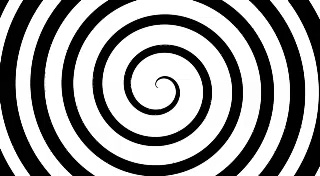3.4 Spiral after-effect illusion
Finally, interesting effects can be demonstrated by moving examples.
Activity 7 Spiral after-effect illusion
Play the video below and fixate on the centre of the spiral for 20 seconds. After this time look at the back of your hand. What happens?
Why might this be the case? Note down what you think might cause this illusion, or any thoughts you have on your experience of it.
Discussion
This is a demonstration of the motion after-effect. When you look at the back of your hand, or any other static object, after having been exposed to this spiral, it appears that the new object is moving in the opposite direction to the spiral. This is explained by adaptation of the neurons encoding movement in that particular direction. We have specific neurons specialised for detection of movement in different directions, and activity of these neurons is usually well balanced. When exposed to this example, those neurons that are activated by the motion in the spiral become fatigued and the balance of activity of other neurons is shifted in favour of those that are specialised for movement in the opposite direction to the spiral. Therefore, we experience motion where there is none, and the static object we have focused our eyes on appears to be moving in the opposite direction to the spiral.

